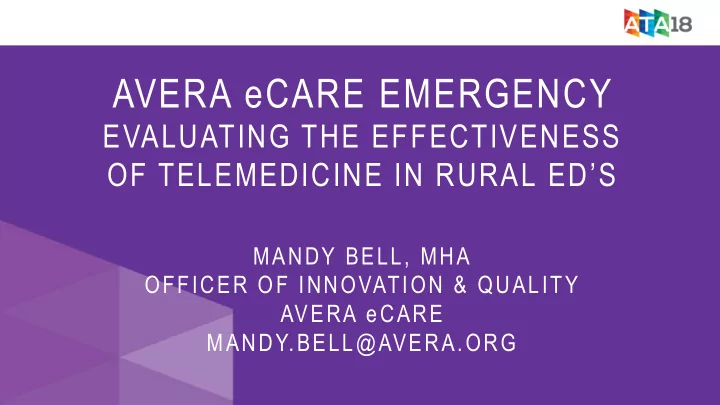

AVERA eCARE EMERGENCY EVALUATING THE EFFECTIVENESS OF TELEMEDICINE IN RURAL ED’S MANDY BELL, MHA OFFICER OF INNOVATION & QUALITY AVERA eCARE MANDY.BELL@AVERA.ORG
AVERA eCARE EMERGENCY Immediate video access to board-certified emergency physicians and nurses
SERVE HIGH-ACUITY EMERGENCY PATIENTS
T-PART PARTICIPATION TO DATE T-PART Volume by Facility T-PART Volume by Complaint 287 Sakakawea Medical Center 202 Pipestone County Medical Center Chest Pain 197 Phillips County Hospital 339 188 Avera DeSmet Memorial Hospital 184 Avera St. Anthony's Hospital Acute Myocardial 134 77 177 Avera Holy Family Hospital Infarction 38 165 Avera Creighton Hospital Stroke 164 Sioux Center Health 154 Avera Flandreau Hospital Severe Sepsis or 147 Avera Platte Health Center Septic Shock 137 Johnson Memorial Health Services 2081 114 Avera Wagner Community Memorial Hospital Other 100 Bowdle Healthcare Center 98 Avera St. Mary's Hospital 94 Avera Weskota Memorial Hospital 75 Avera St. Benedict Health Center 74 Redfield Community Memorial Hospital 2,669 Records Delivered to Date 56 Harlan County Health System 56 Avera St. Michael's Hospital
PROPOSED AVERA RESEARCH • Study impact on Timeliness of Care • Study impact on Patient Disposition • Evaluate impact on ER Staffing & Confidence • Clinical Quality Research: – Emergency Airway Management – Chest Pain/AMI Care – Stroke – Trauma Care – Sepsis – Mental Health
COLLABORATIVE PROJECTS
PATIENT DISPOSITION PURPOSE: Examine the rates of avoided transfers in rural emergency departments that adopted tele-emergency applications; and estimate the costs and benefits of using tele- emergency to avoid transfers. MATERIALS & METHODS: • 9,048 Tele-emergency encounters across 85 rural hospitals within 7 states between Oct. 2009 – February 2014 • Physicians indicated whether the transfer was avoided because of the tele- emergency activation • Cost-benefit analysis conducted from hospital, patient and societal perspectives, and includes technology costs.
PATIENT DISPOSITION RESULTS: Physicians indicated 1,175 avoided transfers were attributed to tele-emergency. $5,563 in avoided transportation and indirect patient costs -$,1739 in tele-emergency costs per avoided transfer $3,824 in net savings to society
PATIENT DISPOSITION CONCLUSION: • Telemedicine has the potential to… Reduce the number of transfers of ED patients Generate revenue for rural hospitals Incur substantial patient savings
PURPOSE: Measure impact of Emergency Department-based telemedicine on timeliness of care in participating rural hospitals. MATERIALS & METHODS: • 14 hospitals selected in 5 Midwest states (IA, KS, NE, ND, SD) • Telemedicine cases matched 2:1 with controls based on age, diagnosis and hospital • Primary outcome: Time-to-provider • Secondary outcomes: Emergency Department Length-of-Stay, Time-to-transfer in those transferred to other hospitals
TIMELINESS OF CARE RESULTS: Telemedicine provider was first in seeing the patient in Door-to-provider time …Of these cases, 42% was shorter in telemedicine was telemedicine patients 14.7 minutes earlier of telemedicine by 6 minutes encounters than local providers Telemedicine First, 42% Local First
TIMELINESS OF CARE
TIMELINESS OF CARE Door-to-provider time by facility Dark gray bars show where telemedicine is consulted Light gray bars show where telemedicine was not consulted
TIMELINESS OF CARE CONCLUSION: • Telemedicine decreases ED door-to-provider time • Among transferred patients, ED LOS at the first hospital was shorter in patients who had telemedicine consulted
PATIENT DISPOSITION PURPOSE: Describe the effect of telemedicine on management and clinical outcomes for trauma patients in North Dakota. MATERIALS & METHODS: Cohort study of adult (age ≥ 18 years) trauma patients treated in North Dakota Critical Access Hospital (CAH) Emergency Departments (EDs) from 2008 to 2014. Multivariable generalized estimating equations were developed to identify associations between telemedicine consultations and availability and outcomes such as transfer, timeliness of care, trauma imaging, and mortality .
PATIENT DISPOSITION
PATIENT DISPOSITION Telemedicine was consulted for 11% of patients in telemedicine- capable EDs & 4% of total trauma patients
PATIENT DISPOSITION Association between telemedicine utilization and ED LOS (transferred and non-transferred patients): • Patients who transferred had a 29.6 minute decrease in the LOS at the first hospital when telemedicine was used, but no effect in those not transferred • Telemedicine availability was associated with a 15.4 minute increase in ED LOS among transferred and non-transferred • Telemedicine use results in an earlier arrival time of 33.6 minutes
PATIENT DISPOSITION CONCLUSION: • ED-based telemedicine consultation is requested for the most severely injured trauma patients • Telemedicine consultation associated with more rapid inter-hospital transfer • Telemedicine availability associated with increased radiography use and transfer
IMPROVING ACCESS PURPOSE: Real-time access to sepsis experts as part of an ED-based telemedicine network can decrease overall variation in care and improve clinical outcomes. MATERIALS AND METHODS: ED telemedicine initiatives for sepsis was implemented in tandem with ongoing system-wide process improvement in treating sepsis.
IMPROVING ACCESS Results: Overall, the implementation project increased sepsis consultation rates by 64%. Report highlights the importance of: • System-wide implementation efforts to standardize sepsis quality improvement activities • Objectively defining consultation criteria • Defining patient groups most likely to benefit from telemedicine • Clinician engagement and buy-in • Understanding the availability of sepsis screening laboratory tests – only 72% of CAH’s in Avera’s service area had access
IMPROVING ACCESS CONCLUSION: • Increasing telemedicine utilization for sepsis requires a multi-pronged approach • Objectively defining consultation criteria is critical to limit alarm fatigue & identifying patient groups most likely to benefit from telemedicine
CURRENT WORK • Discharge Disposition • ER Staffing • Mental Health • Ongoing Education with Tele-ED
Recommend
More recommend